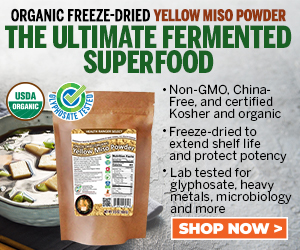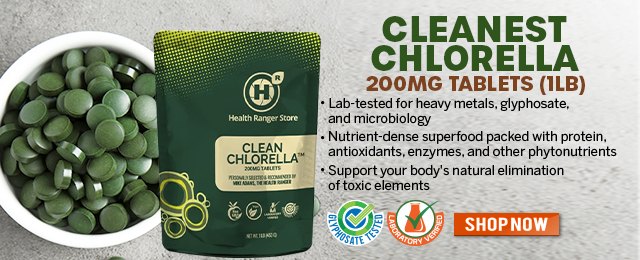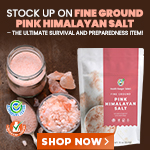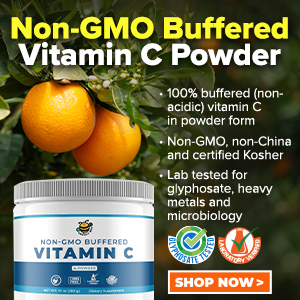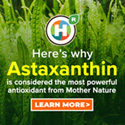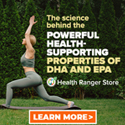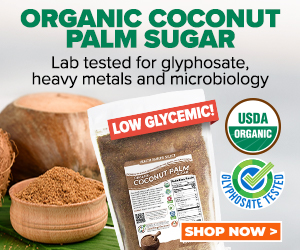
Integrative Medicine journal brings together conventional doctors, naturopaths, nutritionists, chiropractors and others in the healing arts: an interview with Dr. Joseph Pizzorno
 Saturday, April 23, 2005 Saturday, April 23, 2005by Mike Adams, the Health Ranger Editor of NaturalNews.com (See all articles...) Tags: Medical journals, natural health, alternative medicine |
- DIRTY VACCINES: Dr. Anthony "Fraudulent" Fauci, King of the Covid scamdemic, admits "We don't do placebo trials on vaccines"
- Remember, they are not KILLING seagulls, rats or deer, STRANGELY bird flu only affects chickens, cows and humans
- Dr. Robert O. Young’s research notes that ACID BUILDUP may be one of the leading causes of CANCER today
- RFK Jr. takes axe to CDC in historic overhaul of Bill Gates-inspired Epidemic Intelligence Services
- The 20 MILLION DEAD PEOPLE collecting social security payments now are same dead ones who VOTED for BIDEN in 2020 that ILLEGALLY won him the swing states
- The rise of digital authoritarianism: Larry Ellison wants everyone's data and DNA plugged into AI datacenters to guide our behaviors
- FDA misled the judiciary about Pfizer’s vaccine documents
- Decentralized AI: Mike Adams and Maria Zeee advocate for open source solutions to combat centralized control
- South Korean banks halt silver bar sales amid global and domestic uncertainty
- The 99th congress that called vaccines “unavoidably unsafe”
- U.S. faces most severe flu season in 15 Years, but dozens of HOME APOTHECARY EARLY TREATMENTS go ignored by the CDC
- Russian scientist speaks out on the OVER-HYPED threat of microplastics, explains how body adapts to particles this small
- RFK Jr. clears key hurdle: Sen. Susan Collins backs controversial HHS nominee, signaling a new era for health policy
- The hidden danger in your food: Titanium dioxide and the health risks you need to know
- State Farm cancels thousands of home insurance policies in the Pacific Palisades region months before deadly fires
- Undercover USAID ‘Karens’ fighting to keep illegals in their neighborhood were just UNMASKED...
- The Health Ranger launches hot new hip-hop song, "Where The Money Go, Joe?" – with free MP3 download
- Secretary of State Marco Rubio corrects CBS host over free speech and the Holocaust
- RFK Jr. clears key hurdle: Sen. Susan Collins backs controversial HHS nominee, signaling a new era for health policy
- “Cancer Gag Act” threatens farmers’ rights and public health: A dangerous push for corporate immunity
- Democrats cry as “liberal supply chains” are wiped out and their favorite multi-billion dollar money machine is shut down
- PBS shutters DEI office in wake of Trump’s executive order
- James V. DeLong’s book “Out of Bounds, Out of Control” provides a gripping tale of how the EPA operates outside the rule of law
- Trump is taking on the media, exposing defamation and WINNING BIG
- Global tensions, natural disasters and the looming shadow of world war - all predicted by Mike Adams and Steve Quayle three years ago
- Chemotherapy found to increase the number of tumor cells circulating in the blood, spreading it to previously unaffected areas
- The new American dream: $500,000 nuclear bunkers and the fear of WWIII
- UK’s Online Safety Act comes into effect: The dangerous, slippery slope of censorship laws
- A bold step forward: $900M slashed from Federal Education Research Office signals a return to local control
- Studies strongly suggest taurine supplementation can promote longevity
- Stan Johnson on the Health Ranger Report: Henry Gruver’s 2016 vision of second Trump term becomes reality in 2024
- U.S. to sell $300 million upgrade program for South Korean navy’s destroyers
- Yes, the president can deploy troops to enforce immigration law
- Big Banks shift the burden of losses to taxpayers through the Federal Reserve in the form of BAILOUTS
- Is America's "giant debt factory" Federal Reserve setting us up for an economic nightmare?
- Mach 7 drone illustrates China's latest leap in hypersonic technology
- EPA advisor admits the agency is funneling billions to climate groups ahead of Trump’s return to White House
- HYSSOP: What research reveals about the health benefits of this ancient holy herb
- Global leaders unite to clamp down on “misinformation” with UN-backed Cascais Declaration
- I Want My Bailout Money – new song released by Mike Adams
- New BRICS banking system will render Western sanctions on Russia USELESS
- The new American dream: $500,000 nuclear bunkers and the fear of WWIII
- Global tensions, natural disasters and the looming shadow of world war - all predicted by Mike Adams and Steve Quayle three years ago
- Mike Adams Sermon 42: God’s superfruit FIGS can fight warts, staph infections and cancer
- Essential home security tips: Protecting your property without electricity
- Big Banks shift the burden of losses to taxpayers through the Federal Reserve in the form of BAILOUTS
- Trump is taking on the media, exposing defamation and WINNING BIG
- Beyond consequence
- Biden announces additional $500M military aid for Ukraine as California wildfires displace 70,000 residents
- Is America's "giant debt factory" Federal Reserve setting us up for an economic nightmare?
- Homeless crisis in America GETTING WORSE as government continues to spend hundreds of billions on foreign aid
- Health Basics: Top 10 reasons to AVOID ALL VACCINES
- Texas border officials discover unaccompanied 4-year-old girl smuggled from Central America
- Experts warn: Centralized digital currencies could be used to control how people behave
- Red Cross issues warning to stop blood plasma donations from vaccinated people
- Scientists confirm: GENIUS brain function can be spontaneously unleashed in humans without any apparent cause
- DATA: England’s vaccinated population had close to one million deaths in 23 months; unvaccinated population had less than 61,000 deaths over the same period
- HYSSOP: What research reveals about the health benefits of this ancient holy herb
- Arizona residents drive entire Maricopa County Board of Supervisors out of meeting after serving them for TREASON
- Fully vaccinated about to see “tsunami” of illness and death, warns virologist
- Today I asked our AI language model “Neo” about which phytonutrients or phytochemicals can block the spike protein related to SARS-CoV-2 … Here is what it answered…
- BREAKING: 2025 NDAA authorizes mandatory military draft of WOMEN across America… as Pentagon pursues global NUCLEAR war with both Russia and China at the same time
- We are building the infrastructure of human freedom… Brighteon.AI is the next launch that will put life-altering LLM technology into your hands for free
- Michael Yon warns of a ZIONIST TAKEOVER in Trump’s second administration
- ENGINEERED FAMINE: Oregon starts SHUTTING DOWN small farms “to protect the people”
- Two containers with completed ballots fall out of truck in Florida
- NASA admits that climate change occurs because of changes in Earth’s solar orbit, and NOT because of SUVs and fossil fuels
- Ozempic and Wegovy weight loss drugs are injectable LIZARD VENOM PEPTIDES that may unleash a devastating wave of organ failure… side effects align with symptoms of SNAKE BITES
- These 13 countries just signed an agreement to engineer a global FAMINE by destroying food supply
- Careless Whisper: AI-powered transcription tool being used by hospitals found to invent chunks of text no one ever said
- BBC staffers accuse media outlet’s executives of instituting bias in Gaza coverage, claiming favorable treatment of Israel
- Casual restaurant chain TGI Fridays files for BANKRUPTCY
Dr. Pizzorno: Two years ago I became the editor of a new journal called Integrative Medicine, A Clinician's Journal, and what I've done with this journal is create a resource for clinicians, although it can also be read by the educated layperson, and on my board, my editorial board, I have medical doctors, I have naturopathic doctors, I have chiropractors, I have PhDs, I have people from acupuncture, people from nutrition -- basically I'm bringing people from all of the healing arts together to talk about how we can work collaboratively together in the best interests of our patients. So, one of the key elements of our journal is integrated care protocol. So we'll look at a condition like diabetes, for example, and look at when you use, say, the herbs, when you use the nutrients, when you use the drugs, how the drugs and herbs interact with each other, and provide an integrated care profile so that we can provide the best quality care for our patients.
Mike: So, let me ask you about, in the headlines recently, we've seen about other medical journals, this controversy about, now I think 11 of them are saying they're only going to print studies from companies that are willing to print all of the studies. And there's been quite a few accusations of distortions in more conventional journals -- how does your journal differ from that, or does it?
Dr. Pizzorno: Well, I think that's a wonderful trend to see, because I think that indeed there's a lot of negative information and adverse outcomes information on the drugs that has not been properly presented to the clinicians. Our journal doesn't do much original research. We're more interested in integrated protocols, where clinicians have thought through how to do things, and then show how those, how they work, either through controlled studies or through anecdotal reports of patients. So we're not doing basic drug research, and we don't even have, for example, articles on single herbs. I'm not very interested in that -- I'm more interested in integrated care protocols, where we look at everything that can be used.
Mike: So that leads me to I think an important question for readers, which is -- how does a patient assemble a team of integrative care providers?
Dr. Pizzorno: Boy, that's a real challenge, because there are some clinics around where you have practitioners working together, and that's certainly a good start, but most people don't have that ability. So when they go to their doctor, whether it's a medical doctor or a naturopathic doctor, I think their first question would be, "Who do you collaborate with?" If this medical doctor says, "Well, I think this natural medicine stuff is kinda baloney," well, if he were reasonably open-minded he may say, "Well you can use it, it won't hurt you," well, someone like that, why waste your time with them? Go to somebody who says, "Yes, I work well with these people I know that I'm really good in what I do, but I also know there's some areas where I don't have skills, and I have these other people I work with they have high-level skills there, and I'm delighted to work with those people," and that's the kind of doctor you want, regardless of the school of thought. Same thing with a naturopathic doctor -- you go to a naturopathic doctor, and you say, "Well, who do you work with collaboratively?" And they say, "Eh, in that profession they're a bunch of idiots that just kill people." Well, I wouldn't want to go to a naturopathic doctor like that.
Mike: Sadly, it seems though, that so many practitioners in conventional medicine there are still many who are shut, very close minded, to alternative medicine or complementary medicine.
Dr. Pizzorno: I think that's very true, and I think there are unfortunately alternative medicine people whose minds are shut as well. And I thought about this for a lot of years, wondering why we're so hostile towards each other -- I mean, not everybody is, but a lot are, and it occurs to me, we only see each other's failures. So if somebody's happy with what's going on with conventional medicine, they're not going to seek alternatives, and alternatively, someone who is happy with alterative medicine is not going to go seeking conventional medical doctors very often. So it's only when their therapies fail or they get improper diagnosis and treatment that they are likely to go to another practitioner, that other practitioner looks and says, "Well, that wasn't very good care the person got. Boy, these people must not be good health care practitioners." So I think we get a skewed perspective that's not very accurate.
Mike: And then your journal, on the other hand, kind of balances the scale by showing where it works together.
Dr. Pizzorno: Yes, and where it doesn't work together, so we pay just as much attention to drug/herb/nutrient interactions where you have adverse effects. We want to give people good quality, objective, unbiased information about how to practice better medicine, and in many ways, I don't care what you call it, because I think there's a lot of wisdom out there. I think we all have to use the best wisdom available.
Mike: You've led me to another question -- in the press, we always hear about how an herb, usually St. John's Wort, interferes with some prescription drug, but we never hear how a drug interferes with the body or a drug interferes with a nerve.
Dr. Pizzorno: And we should. It's interesting -- many of, maybe the most of side effects from commonly prescribed drugs are due to nutritional abnormalities induced by the drug. And that's one reason why using them both together can be so effective, because if you know what nutritional abnormalities are being induced by the drug, by providing extra amounts of those nutrients, you can help mitigate a lot of the side effects of the drugs.
Mike: Can you give a simple example that people would recognize there?
Dr. Pizzorno: Well, the example I gave already of the coenzyme Q10 being removed by the statin drugs. Another example, and this is very common one, a lot of people are now using cimetadine, and other H2 blockers. Well those H2 blockers, not only do they block the secretion of hydrochloric acid in the stomach, but they also block the secretion of intrinsic factor. Well, intrinsic factor is critical for the absorption of B12. So if somebody's using cimetadine for a long period of time, they're going to develop a B12 deficiency, so we want to give these people extra amounts of B12. Now there are a lot of examples of well-proven nutritional abnormalities induced by drugs that are just being ignored by conventional medicine.
Mike: Because people aren't getting this information from their pharmacists, they're not typically getting it from their doctor, either.
Dr. Pizzorno: Actually, they're more likely to get it from their pharmacist than from their medical doctor, because the pharmacists have better training in the drugs than a medical doctor does.
Mike: Well, that's interesting that you call it a dream -- that's a dream that you are actually helping to make reality, in your books, and with the school. I think a big question people have who are familiar with your work is how do you accomplish so much?
Dr. Pizzorno: Oh! Well, I started out young! I was only 30 years old when I started Bastyr University, so I had a lot of energy then!
Mike: And you have good longevity because you follow your own advice.
Dr. Pizzorno: I do try to follow my own advice. I'm an avid basketball player, and I still play every week with the students, and there's a group of guys I've been playing with for about 15 years, and all but one of the people I started out playing with 15 years ago no longer play anymore. And what was happening, I was noticing that after we played basketball -- and you know, we played for two hours full court, so it was pretty intense -- they'd be popping ibuprofen and aspirin and other anti-inflammatories, and I would be taking glucosamine sulfate and my vitamin C, and my lipoic acid and such.
What was happening was that by taking those anti-inflammatory agents they were decreasing their pain and stiffness afterwards, but they were also blocking the body's ability to repair the damaged tissue, whereas glucosamine sulfate supports the body's own healing process. And so, it's kind of funny, the younger guys are now starting to ask me what I've been taking, because I'm by a sizable margin the oldest person playing with this group of guys.
Mike: And this is glucosamine sulfate, you said, vitamin C, lipoic acid?
Dr. Pizzorno: Right.
Mike: Those are the big three, huh?
Dr. Pizzorno: Well, and other things. I also take more vitamin E, and carnitine. One of the challenges people have is that our mitochondria, which are, you might say, the energy producers in the cells, they wear out over time, and most people, by the time they hit 50, the mitochondria are pretty dysfunctional at that point, and they start going downhill pretty quickly. That's one reason why older people have less energy than young people. Well, it turns out you can delay and slow down the aging process of the mitochondria by using fairly large doses of certain nutrients, and the ones that are of primary importance are lipoic acid, carnitine, vitamin E, and coenzyme Q10. There's actually a fair amount of animal research, and just now we're starting to see human research showing that these are able to substantially improve mitochondrial function in older animals and humans.
Mike: And getting back to COQ10, the production of COQ10 is suppressed by statin drugs, you mentioned.
Dr. Pizzorno: Yes, it is. It's suppressed by stain drugs, and also it's produced in the mitochondria, so as the mitochondria age, it's kind of like a double whammy -- they're being less functional producers of COQ10, which means they're more susceptible to cell damage and they just go down quickly.
You've been reading part four of a five-part interview with Dr. Joseph Pizzorno, the founding president of Bastyr University. Dr. Pizzorno was appointed by President Clinton in December 2000 to the White House Commission on Complementary and Alternative Medicine Policy. President Bush’s administration appointed him to the Medicare Coverage Advisory Committee in February 2003. He is also the co-author of the “Textbook of Natural Medicine” and the “Handbook of Natural Medicine.”
Medical journals at FETCH.news
Get independent news alerts on natural cures, food lab tests, cannabis medicine, science, robotics, drones, privacy and more.
More news on Medical journals
 About the author:Mike Adams (aka the "Health Ranger") is a best selling author (#1 best selling science book on Amazon.com) and a globally recognized scientific researcher in clean foods. He serves as the founding editor of NaturalNews.com and the lab science director of an internationally accredited (ISO 17025) analytical laboratory known as CWC Labs. There, he was awarded a Certificate of Excellence for achieving extremely high accuracy in the analysis of toxic elements in unknown water samples using ICP-MS instrumentation. Adams is also highly proficient in running liquid chromatography, ion chromatography and mass spectrometry time-of-flight analytical instrumentation.
About the author:Mike Adams (aka the "Health Ranger") is a best selling author (#1 best selling science book on Amazon.com) and a globally recognized scientific researcher in clean foods. He serves as the founding editor of NaturalNews.com and the lab science director of an internationally accredited (ISO 17025) analytical laboratory known as CWC Labs. There, he was awarded a Certificate of Excellence for achieving extremely high accuracy in the analysis of toxic elements in unknown water samples using ICP-MS instrumentation. Adams is also highly proficient in running liquid chromatography, ion chromatography and mass spectrometry time-of-flight analytical instrumentation.
Adams is a person of color whose ancestors include Africans and Native American Indians. He's also of Native American heritage, which he credits as inspiring his "Health Ranger" passion for protecting life and nature against the destruction caused by chemicals, heavy metals and other forms of pollution.
Adams is the founder and publisher of the open source science journal Natural Science Journal, the author of numerous peer-reviewed science papers published by the journal, and the author of the world's first book that published ICP-MS heavy metals analysis results for foods, dietary supplements, pet food, spices and fast food. The book is entitled Food Forensics and is published by BenBella Books.
In his laboratory research, Adams has made numerous food safety breakthroughs such as revealing rice protein products imported from Asia to be contaminated with toxic heavy metals like lead, cadmium and tungsten. Adams was the first food science researcher to document high levels of tungsten in superfoods. He also discovered over 11 ppm lead in imported mangosteen powder, and led an industry-wide voluntary agreement to limit heavy metals in rice protein products.
In addition to his lab work, Adams is also the (non-paid) executive director of the non-profit Consumer Wellness Center (CWC), an organization that redirects 100% of its donations receipts to grant programs that teach children and women how to grow their own food or vastly improve their nutrition. Through the non-profit CWC, Adams also launched Nutrition Rescue, a program that donates essential vitamins to people in need. Click here to see some of the CWC success stories.
With a background in science and software technology, Adams is the original founder of the email newsletter technology company known as Arial Software. Using his technical experience combined with his love for natural health, Adams developed and deployed the content management system currently driving NaturalNews.com. He also engineered the high-level statistical algorithms that power SCIENCE.naturalnews.com, a massive research resource featuring over 10 million scientific studies.
Adams is well known for his incredibly popular consumer activism video blowing the lid on fake blueberries used throughout the food supply. He has also exposed "strange fibers" found in Chicken McNuggets, fake academic credentials of so-called health "gurus," dangerous "detox" products imported as battery acid and sold for oral consumption, fake acai berry scams, the California raw milk raids, the vaccine research fraud revealed by industry whistleblowers and many other topics.
Adams has also helped defend the rights of home gardeners and protect the medical freedom rights of parents. Adams is widely recognized to have made a remarkable global impact on issues like GMOs, vaccines, nutrition therapies, human consciousness.
In addition to his activism, Adams is an accomplished musician who has released over a dozen popular songs covering a variety of activism topics.
Click here to read a more detailed bio on Mike Adams, the Health Ranger, at HealthRanger.com.
Take Action: Support Natural News by linking to this article from your website
Permalink to this article:
Embed article link: (copy HTML code below):
Reprinting this article:
Non-commercial use OK, cite NaturalNews.com with clickable link.
Follow Natural News on Facebook, Twitter, Google Plus, and Pinterest
Science News & Studies
Medicine News and Information
Food News & Studies
Health News & Studies
Herbs News & Information
Pollution News & Studies
Cancer News & Studies
Climate News & Studies
Survival News & Information
Gear News & Information
News covering technology, stocks, hackers, and more



"Big Tech and mainstream media are constantly trying to silence the independent voices that dare to bring you the truth about toxic food ingredients, dangerous medications and the failed, fraudulent science of the profit-driven medical establishment.
Email is one of the best ways to make sure you stay informed, without the censorship of the tech giants (Google, Apple, Facebook, Twitter, YouTube, etc.). Stay informed and you'll even likely learn information that may help save your own life."
–The Health Ranger, Mike Adams











